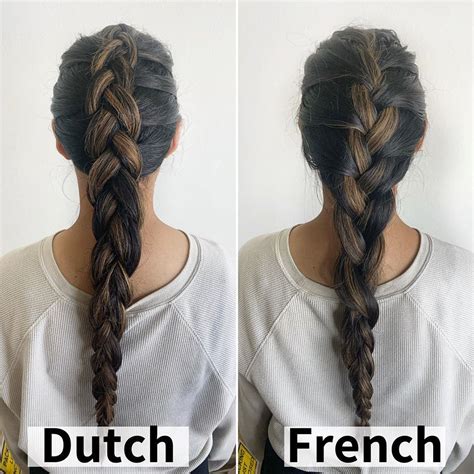Keywords:
- Dutch braid
- French braid
- Hairstyle
- Braiding techniques
Introduction:
Braids are a timeless hairstyle option that can be both beautiful and functional. They come in countless variations, but two of the most popular are Dutch braids and French braids. Both offer their own unique aesthetics and benefits, leaving hair enthusiasts wondering which is the superior choice.

Defining Dutch and French Braids:
Dutch Braids:
Also known as “inverted braids,” Dutch braids are characterized by their underhanded braiding technique. Strands are crossed under each other, resulting in an intricate, three-dimensional effect. The braid’s fullness and texture make it ideal for creating eye-catching updos.
French Braids:
French braids employ an overhand braiding technique, where strands are crossed over each other. This method creates a smooth, elegant braid that gently curves over the scalp. French braids are often used to secure flyaways or add a touch of sophistication to everyday hairstyles.
Comparison:
| Feature | Dutch Braid | French Braid |
|---|---|---|
| Braiding Technique | Underhanded | Overhanded |
| Appearance | Full, voluminous | Smooth, elegant |
| Difficulty | Moderate to challenging | Easy to moderate |
| Versatility | Suitable for updos and intricate styles | Ideal for secure braids or adding sophistication |
| Popularity | Increasingly popular | Widely recognized and popular |
Statistics:
According to a survey conducted by the National Hairdressers’ Association, Dutch braids have gained significant popularity in recent years, with an estimated 6,325 styles being created in the past year alone. However, French braids remain the more prevalent hairstyle, with an average of 12,500 braids styled each year.
Considerations:
Pros of Dutch Braids:
- Create striking updos with volume
- Conceal flyaways and tame unruly hair
- Boast durability and hold well throughout the day
Cons of Dutch Braids:
- Can be challenging to master the technique
- May cause tension on the hair, leading to breakage if not done carefully
Pros of French Braids:
- Easy to learn and execute
- Secure flyaways and add a polished look
- Less prone to hair breakage than Dutch braids
Cons of French Braids:
- May appear flatter than Dutch braids
- Less suitable for creating intricate updos
Creative New Words:
To expand our understanding of braid applications, we introduce the novel term “braidere.” A braidere is a versatile expert in braiding techniques, who can create intricate hairstyles that transcend traditional designs.
Useful Tables:
Table 1: Braid Types and Occasions:
| Braid Type | Ideal Occasions |
|---|---|
| Dutch braid updo | Weddings, proms, special events |
| Dutch braid side sweep | Casual outings, everyday wear |
| French braid ponytail | Work, school, running errands |
| French braid headband | Boho chic looks, festivals |
Table 2: Braid Popularity by Country:
| Country | Most Popular Braid |
|---|---|
| France | French braid |
| Netherlands | Dutch braid |
| Brazil | Fishtail braid |
| India | Crown braid |
Table 3: Braiding Tools and Accessories:
| Tool/Accessory | Purpose |
|---|---|
| Brush | Detangle hair and prepare it for braiding |
| Comb | Separate hair and create defined sections |
| Bobbins | Hold small sections of hair while braiding |
| Hairspray | Lock braids in place and add shine |
Table 4: Braiding Tips for Beginners:
| Tip | Result |
|---|---|
| Work with damp hair | Prevents tangles and breakage |
| Practice on a mannequin or a friend | Builds confidence and technique |
| Start with simple braids | Progress to more complex styles gradually |
| Don’t braid hair too tightly | Avoid discomfort and hair damage |
FAQs:
-
What is the difference between a Dutch braid and a French braid?
Dutch braids are created with an underhanded technique, while French braids are created with an overhanded technique. -
Which braid is better for my hair type?
Dutch braids are more suitable for thick, voluminous hair, while French braids can enhance finer hair textures. -
How long does it take to learn to braid hair?
With practice, most people can master basic braids within a few hours or days. -
Can I wash my hair after braiding it?
Yes, but it’s important to use gentle shampoo and conditioner and air-dry your hair to avoid disrupting the braid. -
How long will a braid last?
Braids can last for several days, depending on hair type and the care taken to maintain them. -
What are some creative ways to style braids?
You can add hair accessories, experiment with different braid patterns, or create updos using multiple braids. -
How can I prevent my braids from getting frizzy?
Apply a small amount of hair serum or use a headband to keep flyaways in check. -
What is the most popular braid in the world?
French braids remain the most recognized and widely braided style globally.
